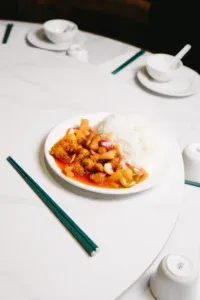Modern Chinese Fusion: Tradition or Innovation?
Modern Chinese fusion celebrates balance, flavour, and history while offering fresh twists on authentic culinary traditions. Yet, as dining habits change, so do the dishes. Today, chefs face an exciting question: should they fuse old recipes with modern trends or preserve traditions in their purest form? This debate shapes how Chinese food evolves in homes and restaurants worldwide.
The Heart of Traditional Chinese Food
 Chinese cooking reflects centuries of culture. Recipes focus on harmony between flavours, colours, and textures. Every region has its speciality, from spicy Sichuan dishes to delicate Cantonese dim sum. Families pass down recipes like heirlooms, preserving stories within each bite.
Chinese cooking reflects centuries of culture. Recipes focus on harmony between flavours, colours, and textures. Every region has its speciality, from spicy Sichuan dishes to delicate Cantonese dim sum. Families pass down recipes like heirlooms, preserving stories within each bite.
However, modern diners crave variety. Globalisation and social media have made people adventurous. As a result, chefs experiment more, creating bold versions of classics. This shift sparks debate: does innovation strengthen tradition or risk losing authenticity?
Modern Chinese Fusion: Creativity on the Plate
Borrowing from Global Flavours
Fusion cooking adds new elements to Chinese classics. For example, bao buns now appear with fillings like pulled pork or falafel. Similarly, chefs mix soy sauce with European herbs or pair dumplings with cheese. These twists attract younger diners and introduce Chinese food to new audiences.
Benefits of Fusion Cooking
Fusion creates excitement. It keeps menus fresh and appealing to people who want something different. Furthermore, it helps Chinese food reach global tables by blending familiar flavours with new experiences.
Restaurants benefit too. Unique dishes often gain attention on social media, drawing curious customers eager for something trendy. Consequently, fusion supports business growth and keeps dining dynamic.
Preservation: Respecting the Roots
Keeping Heritage Alive
Preservation means holding on to the flavours that define culture. Traditional Chinese cooking uses time-honoured methods like steaming, braising, and stir-frying. Dishes such as Peking duck or mapo tofu carry deep meaning. They connect people to their ancestry and remind them of home.
Why Authenticity Matters
Authentic food ensures stories survive. Without preservation, younger generations may lose touch with their culinary roots. Moreover, tourists often travel to taste “real” Chinese flavours, not adapted versions. Therefore, keeping dishes traditional protects cultural identity.
Modern Chinese Fusion: Balance Between Old and New
Many chefs now search for balance. They respect tradition while making small changes for modern tastes. For instance, healthier versions of stir-fries use less oil but still keep classic flavours. Similarly, vegetarian twists replace meat without changing core seasonings.
This middle path allows culture to stay strong while adapting to modern lifestyles. It also prevents traditional food from feeling outdated.
Modern Twists That Work
Dim Sum with a Difference
 Dim sum has long been a favourite. Today, chefs fill dumplings with surprising ingredients such as truffle or smoked salmon. While different, the careful folding and steaming still respect tradition.
Dim sum has long been a favourite. Today, chefs fill dumplings with surprising ingredients such as truffle or smoked salmon. While different, the careful folding and steaming still respect tradition.
Sweet Meets Spicy
Another trend pairs sweet and spicy. Classic kung pao chicken now appears with fruity sauces like mango or pineapple. These additions offer freshness without changing the dish’s base identity.
Plant-Based Adaptations
Veganism and vegetarianism influence many kitchens. Chefs replace pork buns with mushroom or jackfruit versions. These swaps satisfy modern values while retaining the beloved bun experience.
Modern Chinese Fusion: The Role of Diners
Ultimately, diners decide the future of Chinese cuisine. Their choices shape what stays and what evolves. Some prefer classic comfort. Others enjoy bold fusion. Most appreciate both, depending on the occasion.
In cities like London or Manchester, restaurants often mix approaches. Casual spots experiment with fusion, while heritage restaurants keep traditions alive. Together, they offer a variety that celebrates Chinese food in every form.
Looking Ahead: The Evolution Continues
Chinese cuisine will keep changing. Technology, health trends, and global connections ensure constant evolution. Yet, the essence remains: balance, harmony, and respect for flavour. Whether through fusion or preservation, the goal stays the same – bringing joy to the table.
Final Thoughts
The debate between fusion and preservation is not about right or wrong. Instead, it highlights the strength of Chinese cuisine. By embracing both innovation and tradition, chefs ensure Chinese food continues to inspire, delight, and connect people worldwide.